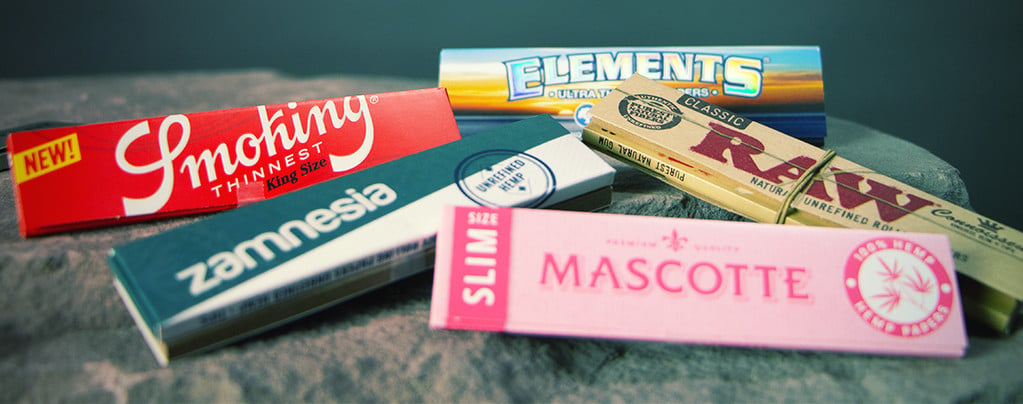
How To Select The Right Type & Size of Rolling Paper
Using good rolling papers can make all the difference. But with the sheer amount of smoking accessories available today, what types of papers are available and which ones are best for smoking cannabis? Are you getting the most out of your smoke? How can you tell? We have put together a handy guide to help you determine the ideal type, size and thickness of rolling paper to choose.
Rolling a good old joint or spliff is still what most folks do when they want to enjoy cannabis, even as other methods like vaporizers and edibles become more popular. If something has changed compared to just a few years back, it’s that cannabis lovers now have a huge selection of smoking products available to them, including many different types of rolling papers. And for rolling a nice fat one, you want the perfect paper to create the best experience.
Rolling Papers: Find Out Which Type Suits Your Needs Best
Before we take a look at the various types of rolling papers that you can buy today, let us clear something up first: How someone likes their joint is really a matter of personal preference and this means there isn’t one “best” rolling paper material per se. You may find one type of paper suits you better than others, depending on your own method of rolling and how you like to smoke.
HOW DO ROLLING PAPERS DIFFER?
Rolling papers don’t just differ in their branding and packaging. The biggest difference is the material used to make them. These include papers made from wood pulp, rice and hemp. Each of these materials has its own pros and cons and can affect things like your joint's burn rate, taste and how easy it is to roll. We take a closer look at the most common materials used below.

But aside from the paper materials used, there are other variables that influence rolling papers, such as the gum used, the paper’s dimensions and yes, even the packaging. Some smokers prefer their rolling papers to be made only from natural materials that are environmentally friendly, so this can be a criterion.
DIFFERENT TYPES OF PAPER MATERIALS

WOOD PULP
Rolling papers made from wood pulp were the very first ones available and are still the most commonly used. This is pretty much the same type of paper used to make cigarettes and everyday writing paper that you’d use for your grocery list. Because it is so common, you can get this type of rolling paper practically everywhere.
The biggest advantage of these papers is that they are easy to use, which makes them good for those who are still learning to roll a joint. Papers from wood pulp have a medium-to-fast burn rate and joints that you make with them will usually stay lit pretty well.
The disadvantage of these standard wood pulp papers is that they have the most noticeable aftertaste, unlike papers made from other materials. These papers don’t just have a taste that some dislike, they also contain the most impurities and will produce the most ash. Most importantly, there are health concerns associated with this type of paper.
Not all papers made from wood pulp are the same, though. Depending on the brand, they can still differ in their material composition and in other areas. Some papers are made from 100% wood pulp, while others may be made from a blend of pulp with other materials like flax.
In order to give the standard wood pulp papers their white appearance, they are often bleached with chlorine or some other chemicals. These chemicals used for bleaching, in addition to not being healthy, will also add to the unnatural taste. You can also find unbleached wood pulp papers today, which are usually brown or translucent.
RICE PAPERS
Rolling papers made from rice are normally the thinnest papers, which means they have the least-noticeable taste. But here too, not all rice rolling papers are the same. Some are made with flax or other additives. Most reputable brands list the paper’s materials right on the package. At very least, you should be able to look it up on their website.
Rice rolling papers’ lack of taste is their biggest advantage, but they come with some drawbacks. Rice paper is very thin, which can make rolling a fat one quite a challenge, especially for those who are still learning the art of crafting the perfect jay.
They are slow-burning, which can be an advantage, but it also means that your joint can go out if you take too long of a break.
HEMP ROLLING PAPERS
Hemp rolling papers combine most of the benefits of the above types, without any of the drawbacks. They are made from 100% natural hemp fibre and most of the time, they come unbleached. Hemp papers are not as thin as rice and normally have some texture that makes them easy to grip. This makes for ideal rolling.
Pure hemp paper isn’t entirely free from taste, but unlike wood pulp and papers with unnatural additives, the hemp adds a mild, sweet and musky taste that most smokers consider pleasant. Hemp paper also burns slowly, but stays lit better than rice paper.
Papers made from natural hemp fibre make for the most natural and “green” way to smoke. Most are unbleached and made without any chemicals, including for the gum used. Many cannabis enthusiasts agree that hemp papers offer the best cannabis smoking experience.
How To Determine The Best Size Rolling Paper For A Perfect Smoke

Perfecting the art of rolling a joint depends so much on the material you are using. Have you noticed how different rolling papers impact the quality of your joint? Have you ever even considered why different varieties emerged in the first place?
When tobacco and other herbs were introduced to Europe, they were generally consumed by the rich who could afford to import them. The cigar butts thrown away by aristocrats were then rolled together in newspapers to be smoked by the poor. The inks and other chemicals present in newspapers caused significant health problems when their smoke was inhaled. So, paper manufacturers started producing safer kinds of rolling paper as smoking became more popularised.

Here's a breakdown of the range of rolling papers the market has demanded, so that you can discover which one works best for you.
SINGLE WIDE
Single wide papers typically measure 68-70mm in length and 34-36mm in width. These are widely available as they do not require very much paper to produce. They are small and thin, often translucent. Such thin paper is difficult to roll and they are not ideal for cannabis smoking. They do burn well with tobacco and are somewhat convenient if you're having a small smoke to yourself.
DOUBLE WIDE
As the name suggests, these are double the size of single wides, measuring roughly 76-78mm in length and 63-88mm in width. These are not as widely available and are perhaps more suited to special occasions. If one is looking to roll a thick cone to share with friends, then double wides fit the bill. Just make sure you pack it efficiently. You don't want the treat you're breathing in to be more paper than herb.
Size 1¼
Extending a single wide by 25% gives you a 1¼-sized paper. These measure about 76-78mm in length and 45-48mm in width. This is closer to the length of a conventional, mass-produced cigarette. These are better suited for passing amongst a small group and for rolling into a cone shape. As the sizes get larger, the paper can become more durable. Always check the slimness or thickness when buying rolling papers.
Size 1½
Slightly thicker material is typically used to create these rolling papers, which are 50% larger than a single wide. They can be packed more, requiring stronger paper to carry the weight. This should create a longer-lasting smoke given the paper’s ability to keep the flame burning. Passing this around in a small group should be quite satisfying once you've harnessed your ability to roll cones.
KING SIZE
Some coffeeshops in Amsterdam produce massive joints that get photographed with celebrities. In terms of what's widely available to consumers, your largest option for a big huge joint is king size. These can be anywhere from 100-110mm in length and 55-60mm in width. They also come in a slim variety at 105-110mm in length but only 42-46mm in width. These have thinner paper, but it all depends on how much you are looking to smoke in a group. Remember, thinner paper burns quicker.
XXL ROLLING PAPERS
Of course, Zamnesia offers some comically large rolling papers too if you really do have a big smoke planned. These are 44mm wide and up to 300mm long. If you can pack a joint that long, you will find it burns smoothly with a pleasant taste and minimal ash. It is always better to smoke unbleached paper sourced sustainably. After all, rolling papers emerged because of chemical risks that have faced smokers in the past. These ones are made without chemicals and Zamnesia sells many papers produced with such an ethos.
You have plenty of options for your smoke. It all depends on how long you want it to last, how much you're smoking, and who is partaking. Are you taking time for yourself? Or passing it to the left among a group of loved ones? Whatever you're planning, Zamnesia has you covered with some of the best rolling papers on offer.
-
 5 min
23 December, 2019
Every Item You Need To Smoke A Joint For The First Time
Never smoked a joint before? Here is a list of everything you need to enjoy a successful first joint-smoking session.
5 min
23 December, 2019
Every Item You Need To Smoke A Joint For The First Time
Never smoked a joint before? Here is a list of everything you need to enjoy a successful first joint-smoking session.
-
 4 min
5 August, 2019
The 10 Best Rolling Papers
Quality rolling papers are an often overlooking part of smoking weed, but picking the right one can make for a much better experience, and take you one step closer to bliss.
4 min
5 August, 2019
The 10 Best Rolling Papers
Quality rolling papers are an often overlooking part of smoking weed, but picking the right one can make for a much better experience, and take you one step closer to bliss.
-
 3 min
21 December, 2018
Joints, Blunts, And Spliffs: What's The Difference?
Even something as simple as rolling and smoking cannabis can have countless terms and ways it is enjoyed. Breaking down the 3 main types, joints, spliffs, and blunts, will not only give you some...
3 min
21 December, 2018
Joints, Blunts, And Spliffs: What's The Difference?
Even something as simple as rolling and smoking cannabis can have countless terms and ways it is enjoyed. Breaking down the 3 main types, joints, spliffs, and blunts, will not only give you some...
-
 6 min
28 February, 2017
How To Roll A Perfect Joint?
Joints are the go-to method for consuming marijuana all around the world. With these few easy steps and a bit of practice, you will confidently produce sweet joints every time.
6 min
28 February, 2017
How To Roll A Perfect Joint?
Joints are the go-to method for consuming marijuana all around the world. With these few easy steps and a bit of practice, you will confidently produce sweet joints every time.











 United States
United States








